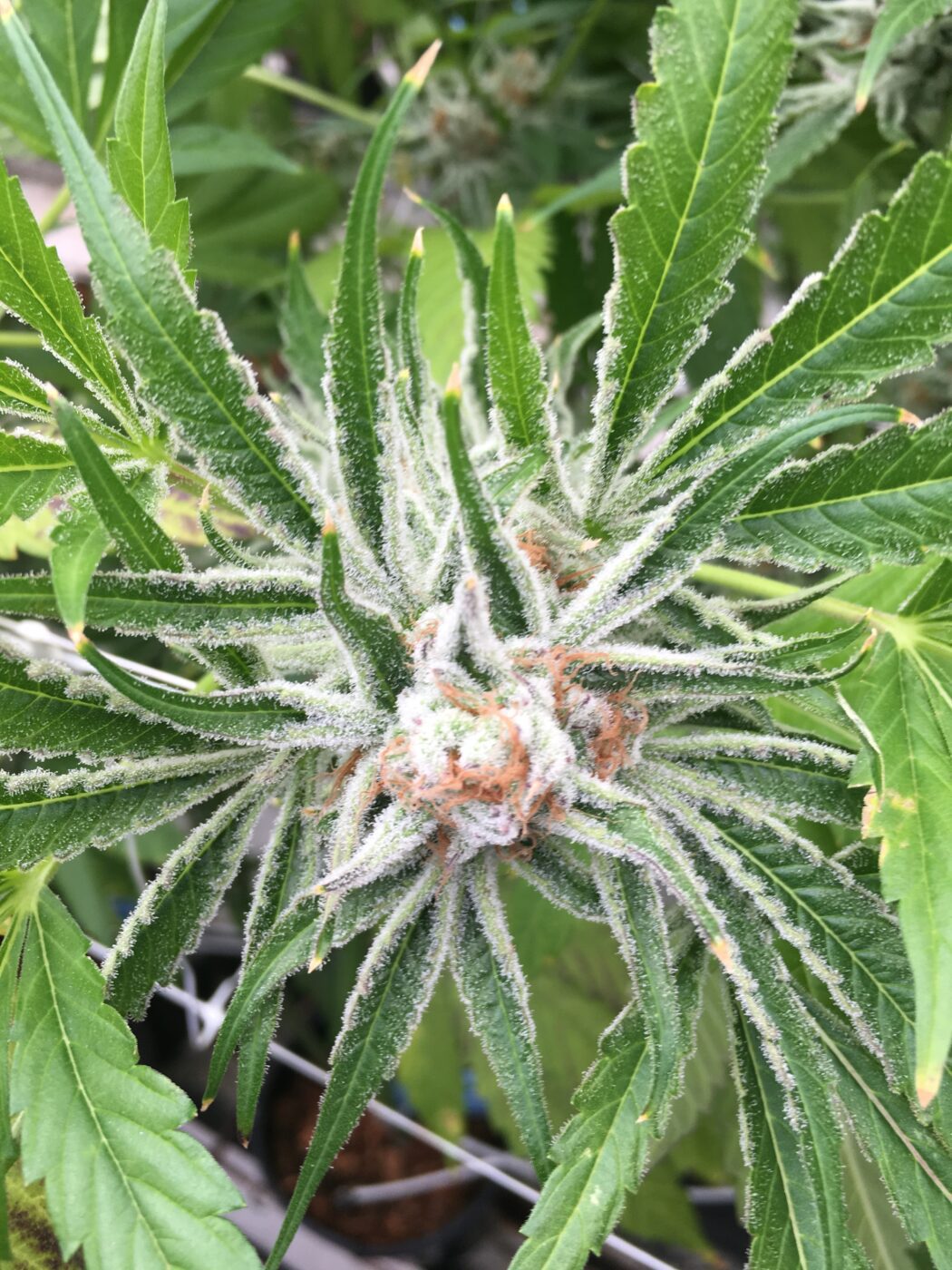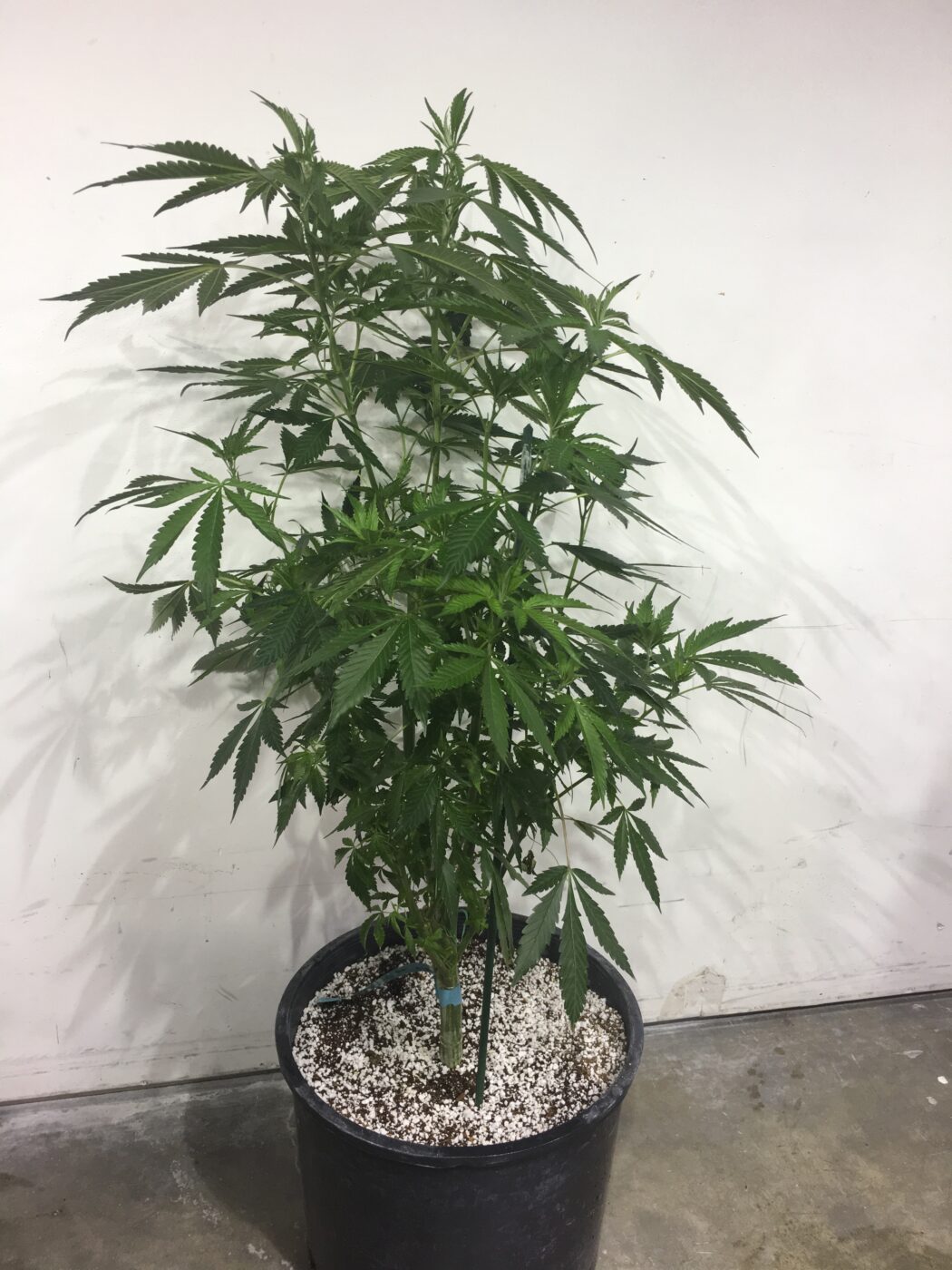Photos courtesy of Dark Heart Nurseries
Many cannabis growers are familiar with Hop latent viroid and the large negative economic impact it is having on the cannabis industry. One study showed that 90% of grow facilities in California had Hop latent viroid (HpLVd) issues and that on average 33% of the plants in these grows were infected. This translates to billions of dollars in lost yields. However, even with the viroid being so common, there is still a lot of misinformation and misunderstanding about it in the growing community.
History Of HpLVd
In Northern California in the early 2010s, cannabis growers began reporting a mysterious disease that caused drastically reduced yields. It was initially unclear what was causing the disease, however there were plenty of colorful names to describe the symptoms — dudding, yellow head, and “the itis,” among many others. The initial symptoms the growers were seeing during vegetative growth were stunted growth, brittle branches, shorter inter-nodal spacing, and smaller spiky leaves. However it was during flower that the viroid was most noticeable. The plants had far fewer trichomes, the flowers were smaller and looser, and the flower smelled more like alfalfa than cannabis. Even more importantly, the yields were greatly reduced, with some reports suggesting 20% or more reductions. Perhaps the biggest problem was no one knew what caused it or how it was spread. But unfortunately, it was spreading, and fast.
Discovery Of HpLVd
The industry had to wait a few years to get any clarity on what was causing cannabis dudding disease. In 2019, Dark Heart Nursery used cutting edge RNA sequencing technologies to make the groundbreaking discovery that Hop latent viroid was the causal agent of cannabis dudding disease. Finally, cannabis growers could put a name to the problem. But there was one additional issue: Most people didn’t even know what a viroid was, let alone how to control it.
What Is A Viroid?
Viroids may sound similar to viruses but in fact they are quite different from each other. Viroids are a group of 27 species of plant pathogens that consist of only RNA and code for no known proteins. Viruses, on the other hand, consist of a DNA or RNA genome that code for proteins and also have a protein coat to protect the DNA or RNA. In fact, viroids are one of the smallest pathogens in the world. For example Hop latent viroid is only 256 nucleotides long. For perspective, the virus that causes COVID is about 30,000 nucleotides long, and Cannabis’s genome is around 800 mega bases (800 million nucleotides) long. Viroids are actually somewhat common in agriculture. They infect many common crops such as potato, tomato, and citrus.
Ok then, you say. But why is it called Hop latent viroid and not Cannabis latent viroid? The simplest answer to that question is that viroids are named for the crop they were first discovered infecting. So in this case Hop latent viroid was first identified in hop plants in Germany in 1988. Since the cannabis viroid strain matched the sequence of the viroid found in hops, it keeps the same name: Hop latent viroid. So does this mean that the viroid moved from hops to cannabis recently? It’s definitely possible. But we cant say that for sure. It could have just as easily gone from cannabis to hops, or, since hops and cannabis are both closely related, it may have even developed in a common ancestor that got passed down to both. One thing that does seem certain is that Hop latent viroid is a much bigger problem in cannabis than in hops.
Clean Source Material
Now that growers finally understood that it was Hop latent viroid causing all of their problems, the next step was working to eliminate it from their grows. This is most commonly done by cleaning your own plant stock or sourcing viroid-free plants directly from nurseries. The first step in cleaning your plant stock is removing any infected material that can serve as a disease source. Growers already had experience at identifying the symptoms of viroid-infected plants and culling them from their garden, so that was an easy first step. Unfortunately, only removing plants if they are symptomatic does not prove 100% effective in eliminating viroid pressure from grows. Due to the latent nature of the viroid, it turns out that only about half of the infected plants are able to be identified by symptoms. The other half of infected plants have what are called latent infections. This means they have an active viroid infection but they are not showing symptoms yet. Importantly, these asymptomatic plants will still serve as a disease source for infecting other healthy plants, so it’s extremely important they get removed from the grow.
How are you supposed to tell if a plant is infected with a pathogen if it isn’t showing any symptoms? Luckily science can help us out with this. There is a scientific process called polymerase chain reaction (PCR) that can be used to identify the RNA of viroids in plants whether they are showing symptoms or not. In fact PCR is one of the most sensitive tests for finding pathogens and is currently the gold standard for identifying COVID infections in humans as well. In short, what this means is that PCR allows us to test plants and determine if they are infected or not, regardless of whether they are showing symptoms.
By utilizing these two methods in tandem you are able to create clean, viroid-free source material, which is extremely important to maintaining a viroid-free environment. Early on, most of this work was done on a grower-by-grower basis, but many nurseries also worked quickly to eliminate the viroid from their facilities as well, and were able to offer viroid-free materials to growers. Two of the most important questions you need to ask before bringing any plant material into your grow are, “Is this material clean?” And, “Has this material been tested for Hop latent viroid?”

Sanitation, Sanitation, Sanitation
Creating or buying viroid-free source material is only half of the equation. The other half is using proper SOPs to ensure that if the viroid does get in your facility, you contain it and aren’t inadvertently spreading it to healthy plants. In order to create the correct processes, we need to understand how the viroid moves from infected plants to healthy plants. At least in this case we are a little lucky. Hop latent viroid is a mechanically transmitted disease and not primarily spread by insects. This means infected plant material coming into direct contact with a wound on a healthy plant, either by plants rubbing together or, most commonly, workers in a greenhouse pruning plants. In fact, the single best thing you can do to prevent the viroid spreading in a grow is sterilizing pruning implements between cutting each plant. It’s also important to understand that not all sanitizers are effective at inactivating the viroid. Currently, it seems Virkon or a 10% bleach solution work the best at inactivating the viroid on pruning implements.
Dealing With HpLVd In The Future
The cannabis industry is still in the early stages of dealing with the viroid problem. Elimination of infected materials has been slow due to the large number of commercially available cannabis strains. However, as awareness has increased over the past three years, so has the rate of testing. The combination of testing and eliminating infected plants does work and is allowing some proactive grows to reduce their viroid load. In turn, these grows are seeing increased yields. While it does take effort from everyone in a production facility to reduce the viroid load, it’s probably one of the quickest ways to improve cannabis yields by 10 to 20% in your grow.
Everyone wants the cannabis industry of the future to be viroid-free. However, it is going to take a concerted effort from everyone in the industry — breeders, nurseries, and growers — to all come together and ensure they aren’t producing or sharing infected materials. Only then can cannabis have its viroid-free future.
Frequently Asked Questions
Is Hop latent viroid seed-transmitted?
Unfortunately, the results from some ongoing research at Dark Heart Nursery show the answer to this question is likely yes. The good news is the infection rate in seeds does appear to be low, likely in the 5 to 8% range.
Is there a cure for Hop latent viroid?
There is currently no large-scale cure for a cannabis crop that is infected with Hop latent viroid. However, it is possible to cure the viroid on an individual strain basis using a pretreatment and meristem tissue culture.

Is it really that big of a deal?
Scientists at Dark Heart Nursery, Richard Philbrook and Sydney Gerstenberg, processed more than 200,000 viroid testing samples over a period of two years. Their results showed that 90% of cultivation sites have viroid issues and that around 30% of the total plants are infected. This translates into a potential loss of $4 billion dollars in the cannabis industry. So yes, it’s kind of a big deal.
Can it really spread from plants touching?
Yes it can. It can also spread from workers touching infected dried flower and then touching plants. However, while this is possible, the biggest cause of spread is always workers pruning in a grow.
Do viroid-infected plants have a lower cloning efficiency?
Yes, viroid infected clones often don’t root well.
Is it really possible to eliminate the viroid from a grow?
Yes it is. All it takes is a combination of a solid testing program and sanitation buy-in from the production team.

